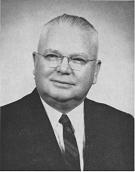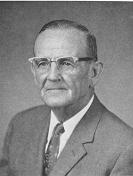|
|
Display Title 1963 Honorary Life Member Inductees
Page Content
 Geoffrey Van Clief Houghland*Geoffrey V. C. Houghland was born in Brooklyn in 1897. When he was 17, he decided to move from the city and start a new life in the country. His agricultural career began as a hired man on a farm in upstate New York. In 1918 he was graduated from the New York School of Agriculture at Morrisville. This same year he was appointed Assistant Agronomist at the Delaware Agricultural Experiment Station. In 1924 he received the B.S. degree in Agronomy from the University of Delaware. His next academic move took him to Iowa State College where he held a teaching fellowship and received the M.S. degree in Soil Bacteriology in 1926. He then moved to the University of Maryland for graduate study. Here he majored in soil fertility and plant physiology and received the Ph.D. degree in 1928. He entered the U. S. Department of Agriculture in 1928 and was first connected with the Division of Soil Fertility where he worked almost entirely on fertilizer problems related to the potato crop. His government service has been devoted to the study of the physiology and growth of potatoes. He helped to develop the band placement method for fertilizers and demonstrated its superiority for potatoes throughout the Eastern States. He devised methods for growing potatoes in solution and gravel cultures and demonstrated their usefulness for the study of potato scab and other problems requiring close nutrient control. He used these methods to show the importance of time in the use of phosphorous on potatoes and for the development of minor element deficiency symptoms. At the present time he is engaged in a project aimed at the production of an industrial potato variety with the highest possible starch content. All of this work has led to the authorship and publication of a long list of scientific articles, technical and farmer’s bulletins all dealing with the production of potatoes and related subjects. He is the author of a chapter on potatoes in Hunger Signs of Crops, and has recently prepared a revision for the forthcoming new issue of this outstanding book. Dr. Houghland is particularly well known to many Long Island potato growers through his fertilizer placement and other fertilizer studies conducted on Long Island for more than 15 years. Long Island growers will also remember the service that he rendered after the damaging hurricane of September 1939. At that time he personally ran more than 500 salt determinations on samples taken from salted fields and made the much needed planting recommendations. Incidentally, for this work he received special commendation from the Secretary of Agriculture, Henry Wallace. Dr. Houghland’s principal hobby is photography. Through this avocation he has photographed potato varieties, diseases, and nutrient deficiency symptoms, and all parts of the potato plant so successfully that his pictures are requested by workers in all parts of the world. It is with pleasure that I present Dr. Geoffrey V. C. Houghland for Honorary Life Membership in the Potato Association of America. ~Raymond W. Buck, Jr., Nominator
 Wesley F. Porter*Mr. Chairman and members of The Potato Association of America. First of all, let me thank the Association for selecting Mr. Porter from Maine as one of those to receive honorary life membership this evening. It is fitting and proper that I thank someone for the invitation to be with you and to tell the Association what I think of the job Wesley F. Porter has done for the potato industry. Mr. Porter, now retired, was for many years Program Director for the State Seed Potato Board. It was my good fortune to be associated with him in various potato programs for about one-quarter of a century and it is a great pleasure for me to say something about Mr. Porter’s work and my association with him. Mr. Porter started his career as an inspector in the State Department of Agriculture, and I had the honor of being associated with him during most of his active service. In addition to his work, there has always been a close personal relationship as well as the friendship which comes from working together as public servants and recognizing in Mr. Porter a real contributor to our most important potato industry. Not of much importance, but it just happens that Mr. Porter and I are both members of the Kappa Sigma Fraternity which we think has a good name in college life. In passing, I would like to say that perhaps he and I had some advantages in the early days of our potato work. We were in the midst of constructing our programs when Dr. Schultz and Dr. Folsom were enjoying an international reputation. They were followed by Dr. Bonde whom many of you know, and I am sure that Mr. Porter would agree with me that he had an excellent opportunity in his early work. It is needless for me to go into detail except to say that Mr. Porter’s contribution to our certified seed work, followed by his being Program Director at Porter Farm in Masardis, did a lot to put Maine in its present position in the seed potato industry. It would be unfair if I didn’t mention that Mr. Porter did much to encourage young men coming into potato work. He was patient with them, did his best to be helpful, and one of his longtime associates, Mr. Ted Humphrey, is now Program Director at Porter Farm. We had difficulties with Porter as we have with anybody, but they were all on the right side of the ledger. For instance, when he hired out as Program Director, the salary was not mentioned. Being familiar with State work, I took occasion to tell him that the Seed Board had indicated that they wanted him and now was the time for him to get a day’s pay if he ever expected to get it. This made no definite impression apparently because it was many weeks after that before he knew what his pay check was going to be. This was typical of the man. His potato work came first and other things fell into line as being of lesser importance. The Seed Board, in my judgment, paid a real tribute to the man whom we are honoring here this evening by naming their farm at Masardis the Wesley F. Porter Foundation Seed Potato Farm. A tablet on a large boulder in the front yard as you enter the farm reads as follows: “In recognition of the valuable services rendered by Wesley F. Porter of Presque Isle to the potato industry of Maine, this farm shall be known as the Wesley F. Porter Foundation Seed Potato Farm. First as a certified seed inspector, later as an assistant in the Maine Agricultural Experiment Station, and finally as program director for the State Seed Potato Board, Mr. Porter’s accomplishments have been outstanding, while his ability to detect potato diseases in the field has seldom been equaled.” I salute the Potato Association for its selection and Mr. Porter for the job he has done. We in the industry are extremely proud of men of his type. As Commissioner of Agriculture of the State of Maine, I again want to thank the Potato Association of America for honoring Mr. Porter. ~E. L. Newdick, Commissioner, Nominator

Nathaniel A. Talmage*Mr. Nathaniel Allen Talmage was born December 17, 1901, in Baiting Hollow, Riverhead township, Long Island, New York. He graduated from Cornell University with a B.S. in Agriculture. He was elected to the Honorary Society, Phi Kappa Phi.
Mrs. Talmage is a Master Weaver and by means of this art is known to many friends throughout the United States and many other countries. Their oldest daughter, Jane, is married to an Air Force officer; sons John and Nat, Jr. are involved in the agricultural industry on Long Island, and their youngest daughter, Mary Ellen, is engaged in hospital work in Australia. Tile Talmage farm, known as Friar’s Head Farm–so named because of high wood-fringed sand dunes giving the appearance of a friar’s bald head when viewed from the Long Island Sound, which borders the farm on the north–has been in the family since 1880, consisting at that time of 120 acres; 30 acres were added in 1890, 50 acres in 1910, 50 more acres in 1926 and 130 acres in 1962. This attests to the fact that in an area where housing developments are taking over good agricultural land, the Talmage farm has continued to thrive and grow. The farm does business under the name of H. R. Talmage & Son and is a partnership between members of the Talmage family. “Nat.” as he is known by his friends all over the United States, has played a major part in the revolution of Long Island potato production and national potato production. Nat and his father introduced portable overhead irrigation on Long Island in 1936. In 1947, he designed and built one of the earliest successful two-row potato harvesters used with home-designed and home-built bulk bodies. Bulk harvesting has been used ever since that time on this farm..One of the earliest modern potato storages was built in 1926 . . . a building 120 feet by 50 feet with no posts . . . which is still very adequate for today’s needs, equipped with modern forced air ventilation. The farm continues to be first in many innovations to Long Island potato production. The bulk bodies at the present time which haul potatoes into the storage in the fall are adapted in the spring to haul bulk fertilizer and bulk seed into the field and deliver it into the potato planter. Of course, the overhead irrigation which was introduced by the Talmage farm, is now standard practice for Long Island potato producers. Nat is past president of the Suffolk County Extension Service Association; past chairman of the Suffolk County 4-H Executive Committee; and past master of Pomona Gange. He is chairman of the Suffolk County Agricultural Advisory Committee at the present time. Since 1950 he has been a director of the National Potato Council and is a frequent advisor to decisions concerning agriculture and potatoes in particular on both a state and national level. He is vice president of the Long Island Produce and Fertilizer Company, a leading farm supplier and potato dealer on Long Island since 1922. Nat has been a constant advocate of unified action by the potato industry to regulate potato production at a level that the free market would use and give a fair price and a realistic return to the producer. Nat Talmage has always been a key figure in all civic ventures in the area. He is a member of Rotary: has been very active in work with the County hospital and church affairs. He has served in both State and national committees with the Congregational Church. It is with great honor that I present to the members of the Potato Association of America Nat Talmage for Honorary Life Membership. I know of no man from industry who so richly deserves the honor at this time.
|
